Population Health: Ottawa Charter and Te Pae Mahutonga Frameworks
VerifiedAdded on 2021/10/07
|9
|2458
|169
Essay
AI Summary
This essay delves into the realm of population health, focusing on the Ottawa Charter and Te Pae Mahutonga as key frameworks for effective health promotion. It begins by defining health promotion and the systems approach in healthcare, highlighting the importance of patient safety and quality of care. The essay then explores the Ottawa Charter, its strategies of advocate, enable, and mediate, and its action areas, such as formulating healthy public policies and strengthening community actions. The Te Pae Mahutonga, a Maori health framework with components like Mauriora, Nga Manukura, and Te Mana Whakahaere, is also examined. The essay integrates both frameworks with a project on smoking prevention among Maori women, demonstrating how cultural identity, autonomy, and environmental protection are incorporated to enhance health promotion. The conclusion emphasizes the significance of both frameworks in promoting health in New Zealand, focusing on their applicability and systems approach to healthcare.
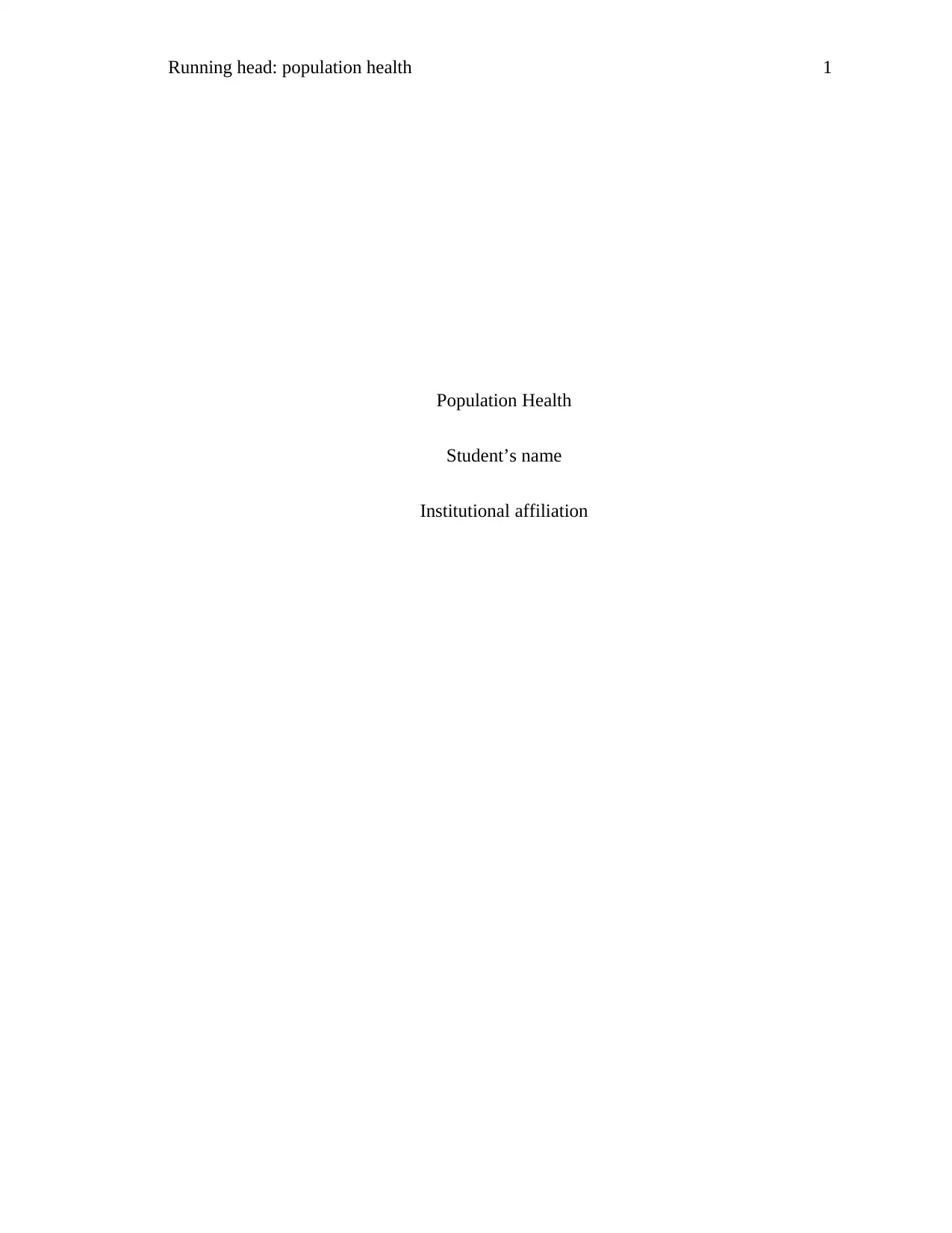
Running head: population health 1
Population Health
Student’s name
Institutional affiliation
Population Health
Student’s name
Institutional affiliation
Paraphrase This Document
Need a fresh take? Get an instant paraphrase of this document with our AI Paraphraser
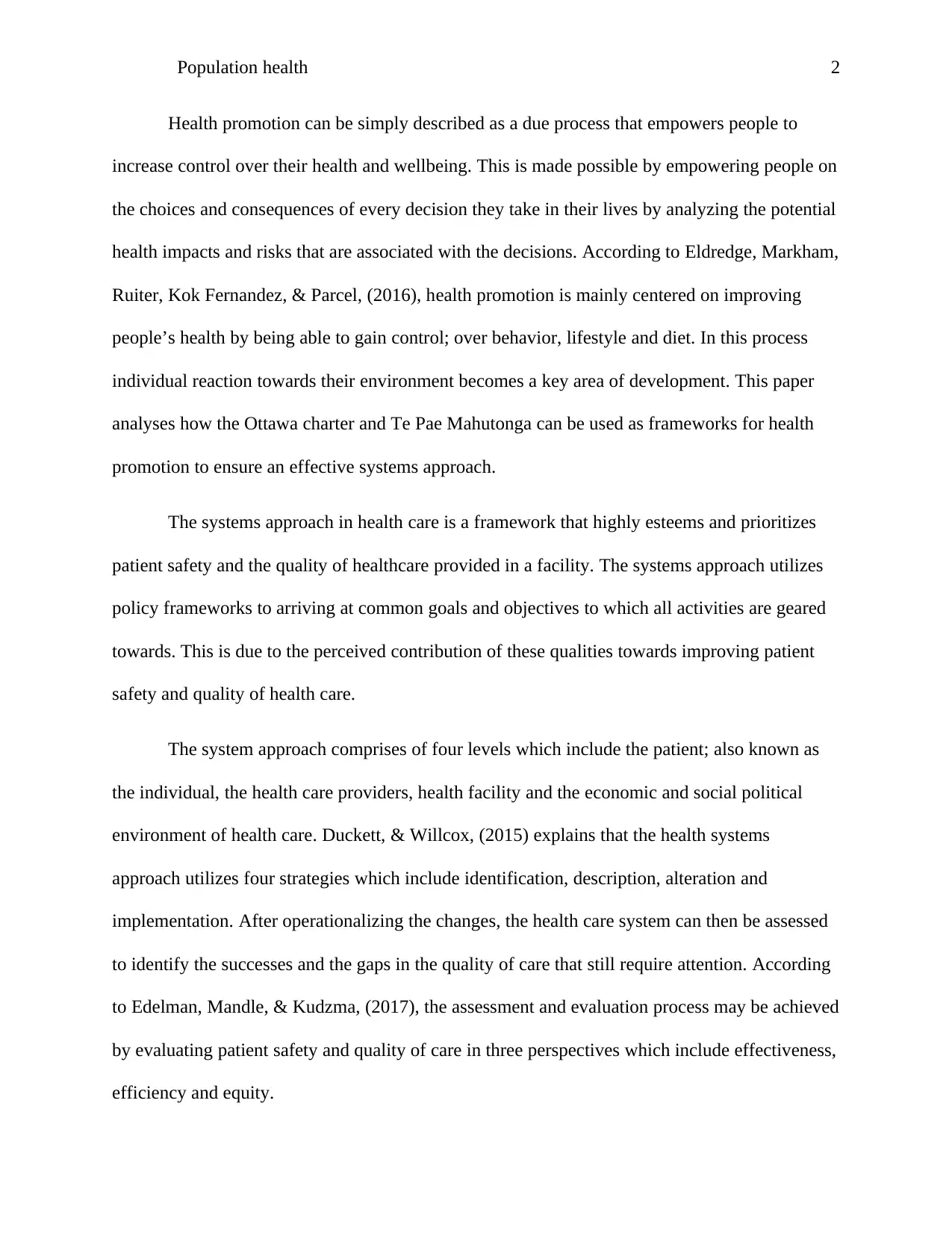
Population health 2
Health promotion can be simply described as a due process that empowers people to
increase control over their health and wellbeing. This is made possible by empowering people on
the choices and consequences of every decision they take in their lives by analyzing the potential
health impacts and risks that are associated with the decisions. According to Eldredge, Markham,
Ruiter, Kok Fernandez, & Parcel, (2016), health promotion is mainly centered on improving
people’s health by being able to gain control; over behavior, lifestyle and diet. In this process
individual reaction towards their environment becomes a key area of development. This paper
analyses how the Ottawa charter and Te Pae Mahutonga can be used as frameworks for health
promotion to ensure an effective systems approach.
The systems approach in health care is a framework that highly esteems and prioritizes
patient safety and the quality of healthcare provided in a facility. The systems approach utilizes
policy frameworks to arriving at common goals and objectives to which all activities are geared
towards. This is due to the perceived contribution of these qualities towards improving patient
safety and quality of health care.
The system approach comprises of four levels which include the patient; also known as
the individual, the health care providers, health facility and the economic and social political
environment of health care. Duckett, & Willcox, (2015) explains that the health systems
approach utilizes four strategies which include identification, description, alteration and
implementation. After operationalizing the changes, the health care system can then be assessed
to identify the successes and the gaps in the quality of care that still require attention. According
to Edelman, Mandle, & Kudzma, (2017), the assessment and evaluation process may be achieved
by evaluating patient safety and quality of care in three perspectives which include effectiveness,
efficiency and equity.
Health promotion can be simply described as a due process that empowers people to
increase control over their health and wellbeing. This is made possible by empowering people on
the choices and consequences of every decision they take in their lives by analyzing the potential
health impacts and risks that are associated with the decisions. According to Eldredge, Markham,
Ruiter, Kok Fernandez, & Parcel, (2016), health promotion is mainly centered on improving
people’s health by being able to gain control; over behavior, lifestyle and diet. In this process
individual reaction towards their environment becomes a key area of development. This paper
analyses how the Ottawa charter and Te Pae Mahutonga can be used as frameworks for health
promotion to ensure an effective systems approach.
The systems approach in health care is a framework that highly esteems and prioritizes
patient safety and the quality of healthcare provided in a facility. The systems approach utilizes
policy frameworks to arriving at common goals and objectives to which all activities are geared
towards. This is due to the perceived contribution of these qualities towards improving patient
safety and quality of health care.
The system approach comprises of four levels which include the patient; also known as
the individual, the health care providers, health facility and the economic and social political
environment of health care. Duckett, & Willcox, (2015) explains that the health systems
approach utilizes four strategies which include identification, description, alteration and
implementation. After operationalizing the changes, the health care system can then be assessed
to identify the successes and the gaps in the quality of care that still require attention. According
to Edelman, Mandle, & Kudzma, (2017), the assessment and evaluation process may be achieved
by evaluating patient safety and quality of care in three perspectives which include effectiveness,
efficiency and equity.
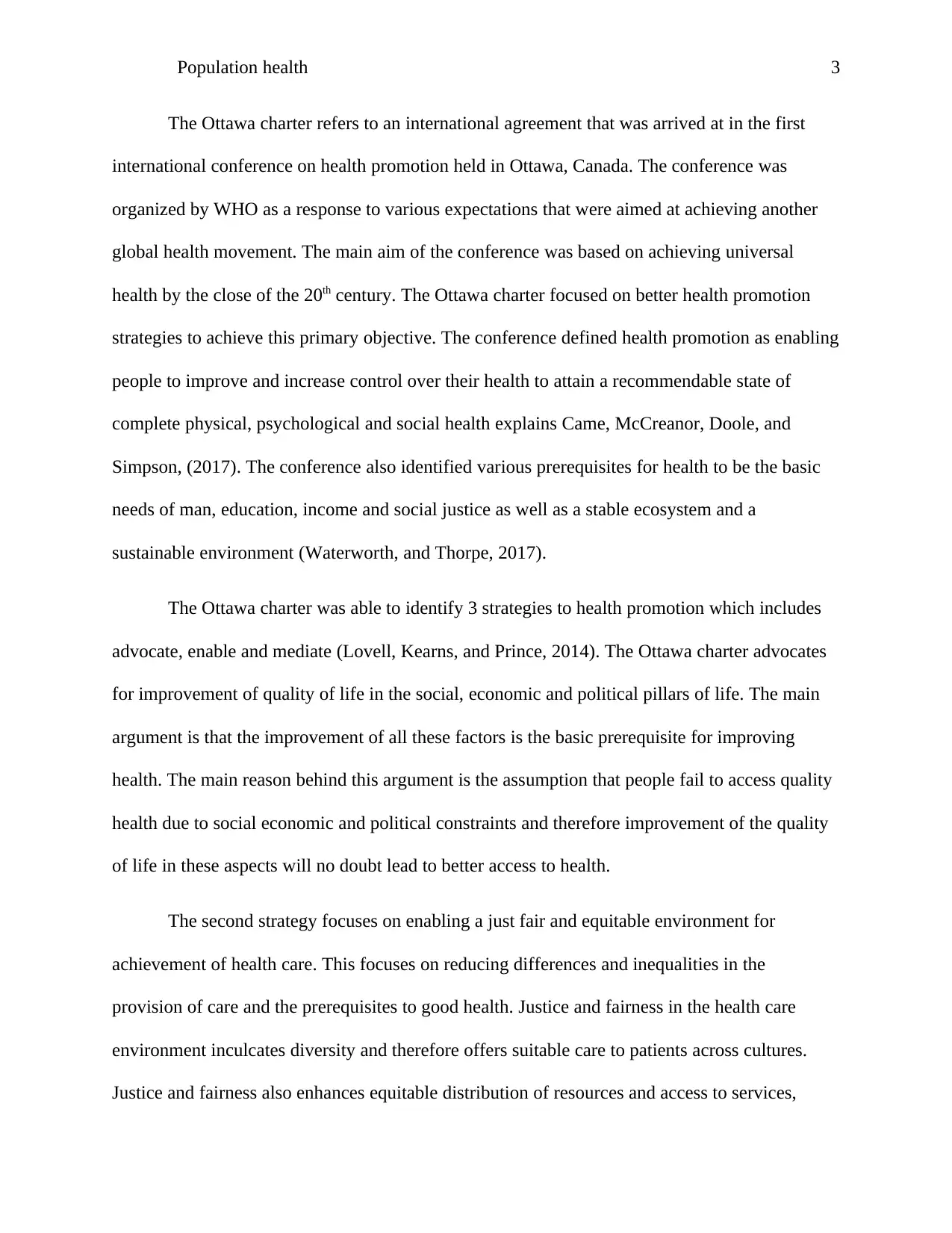
Population health 3
The Ottawa charter refers to an international agreement that was arrived at in the first
international conference on health promotion held in Ottawa, Canada. The conference was
organized by WHO as a response to various expectations that were aimed at achieving another
global health movement. The main aim of the conference was based on achieving universal
health by the close of the 20th century. The Ottawa charter focused on better health promotion
strategies to achieve this primary objective. The conference defined health promotion as enabling
people to improve and increase control over their health to attain a recommendable state of
complete physical, psychological and social health explains Came, McCreanor, Doole, and
Simpson, (2017). The conference also identified various prerequisites for health to be the basic
needs of man, education, income and social justice as well as a stable ecosystem and a
sustainable environment (Waterworth, and Thorpe, 2017).
The Ottawa charter was able to identify 3 strategies to health promotion which includes
advocate, enable and mediate (Lovell, Kearns, and Prince, 2014). The Ottawa charter advocates
for improvement of quality of life in the social, economic and political pillars of life. The main
argument is that the improvement of all these factors is the basic prerequisite for improving
health. The main reason behind this argument is the assumption that people fail to access quality
health due to social economic and political constraints and therefore improvement of the quality
of life in these aspects will no doubt lead to better access to health.
The second strategy focuses on enabling a just fair and equitable environment for
achievement of health care. This focuses on reducing differences and inequalities in the
provision of care and the prerequisites to good health. Justice and fairness in the health care
environment inculcates diversity and therefore offers suitable care to patients across cultures.
Justice and fairness also enhances equitable distribution of resources and access to services,
The Ottawa charter refers to an international agreement that was arrived at in the first
international conference on health promotion held in Ottawa, Canada. The conference was
organized by WHO as a response to various expectations that were aimed at achieving another
global health movement. The main aim of the conference was based on achieving universal
health by the close of the 20th century. The Ottawa charter focused on better health promotion
strategies to achieve this primary objective. The conference defined health promotion as enabling
people to improve and increase control over their health to attain a recommendable state of
complete physical, psychological and social health explains Came, McCreanor, Doole, and
Simpson, (2017). The conference also identified various prerequisites for health to be the basic
needs of man, education, income and social justice as well as a stable ecosystem and a
sustainable environment (Waterworth, and Thorpe, 2017).
The Ottawa charter was able to identify 3 strategies to health promotion which includes
advocate, enable and mediate (Lovell, Kearns, and Prince, 2014). The Ottawa charter advocates
for improvement of quality of life in the social, economic and political pillars of life. The main
argument is that the improvement of all these factors is the basic prerequisite for improving
health. The main reason behind this argument is the assumption that people fail to access quality
health due to social economic and political constraints and therefore improvement of the quality
of life in these aspects will no doubt lead to better access to health.
The second strategy focuses on enabling a just fair and equitable environment for
achievement of health care. This focuses on reducing differences and inequalities in the
provision of care and the prerequisites to good health. Justice and fairness in the health care
environment inculcates diversity and therefore offers suitable care to patients across cultures.
Justice and fairness also enhances equitable distribution of resources and access to services,
⊘ This is a preview!⊘
Do you want full access?
Subscribe today to unlock all pages.

Trusted by 1+ million students worldwide
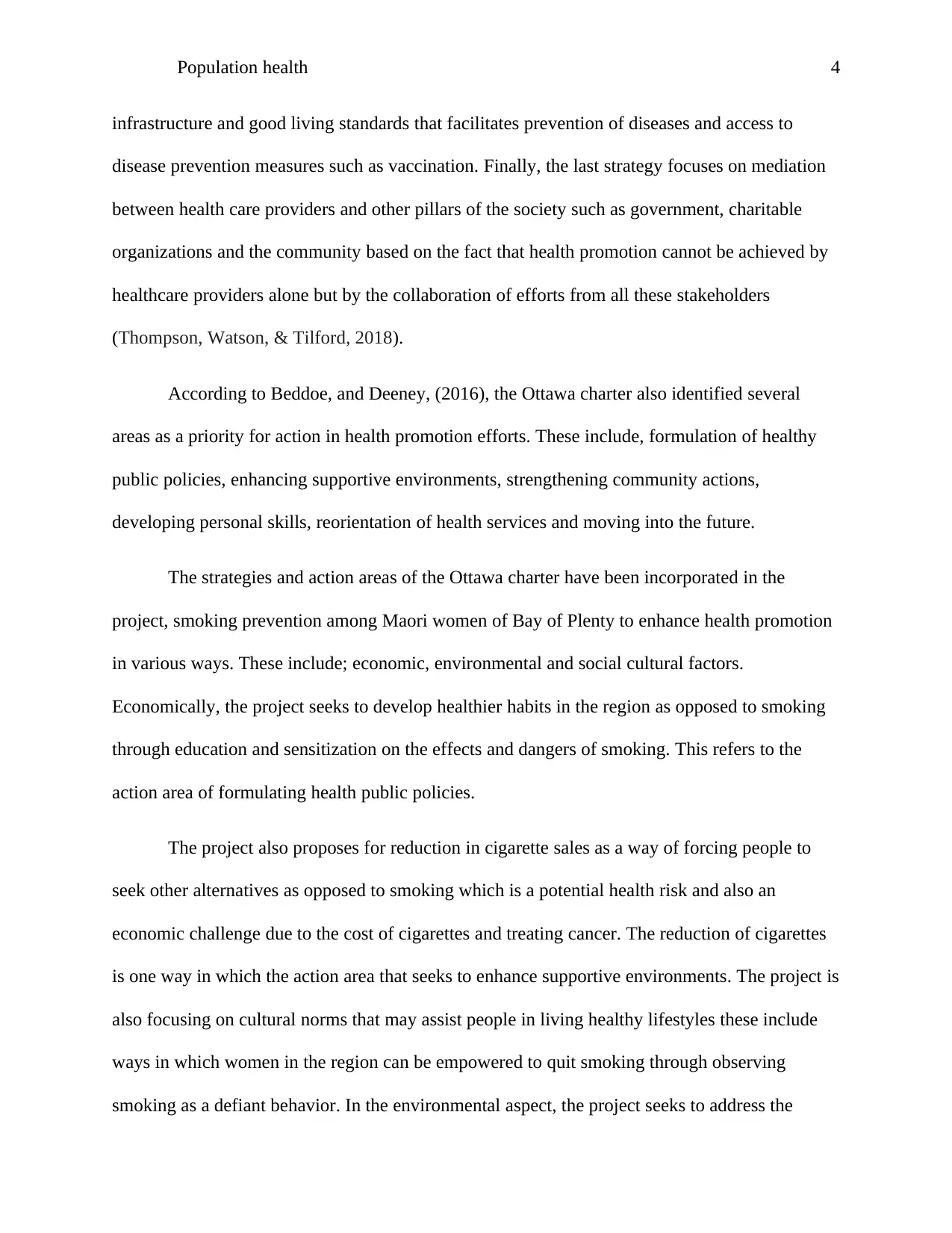
Population health 4
infrastructure and good living standards that facilitates prevention of diseases and access to
disease prevention measures such as vaccination. Finally, the last strategy focuses on mediation
between health care providers and other pillars of the society such as government, charitable
organizations and the community based on the fact that health promotion cannot be achieved by
healthcare providers alone but by the collaboration of efforts from all these stakeholders
(Thompson, Watson, & Tilford, 2018).
According to Beddoe, and Deeney, (2016), the Ottawa charter also identified several
areas as a priority for action in health promotion efforts. These include, formulation of healthy
public policies, enhancing supportive environments, strengthening community actions,
developing personal skills, reorientation of health services and moving into the future.
The strategies and action areas of the Ottawa charter have been incorporated in the
project, smoking prevention among Maori women of Bay of Plenty to enhance health promotion
in various ways. These include; economic, environmental and social cultural factors.
Economically, the project seeks to develop healthier habits in the region as opposed to smoking
through education and sensitization on the effects and dangers of smoking. This refers to the
action area of formulating health public policies.
The project also proposes for reduction in cigarette sales as a way of forcing people to
seek other alternatives as opposed to smoking which is a potential health risk and also an
economic challenge due to the cost of cigarettes and treating cancer. The reduction of cigarettes
is one way in which the action area that seeks to enhance supportive environments. The project is
also focusing on cultural norms that may assist people in living healthy lifestyles these include
ways in which women in the region can be empowered to quit smoking through observing
smoking as a defiant behavior. In the environmental aspect, the project seeks to address the
infrastructure and good living standards that facilitates prevention of diseases and access to
disease prevention measures such as vaccination. Finally, the last strategy focuses on mediation
between health care providers and other pillars of the society such as government, charitable
organizations and the community based on the fact that health promotion cannot be achieved by
healthcare providers alone but by the collaboration of efforts from all these stakeholders
(Thompson, Watson, & Tilford, 2018).
According to Beddoe, and Deeney, (2016), the Ottawa charter also identified several
areas as a priority for action in health promotion efforts. These include, formulation of healthy
public policies, enhancing supportive environments, strengthening community actions,
developing personal skills, reorientation of health services and moving into the future.
The strategies and action areas of the Ottawa charter have been incorporated in the
project, smoking prevention among Maori women of Bay of Plenty to enhance health promotion
in various ways. These include; economic, environmental and social cultural factors.
Economically, the project seeks to develop healthier habits in the region as opposed to smoking
through education and sensitization on the effects and dangers of smoking. This refers to the
action area of formulating health public policies.
The project also proposes for reduction in cigarette sales as a way of forcing people to
seek other alternatives as opposed to smoking which is a potential health risk and also an
economic challenge due to the cost of cigarettes and treating cancer. The reduction of cigarettes
is one way in which the action area that seeks to enhance supportive environments. The project is
also focusing on cultural norms that may assist people in living healthy lifestyles these include
ways in which women in the region can be empowered to quit smoking through observing
smoking as a defiant behavior. In the environmental aspect, the project seeks to address the
Paraphrase This Document
Need a fresh take? Get an instant paraphrase of this document with our AI Paraphraser
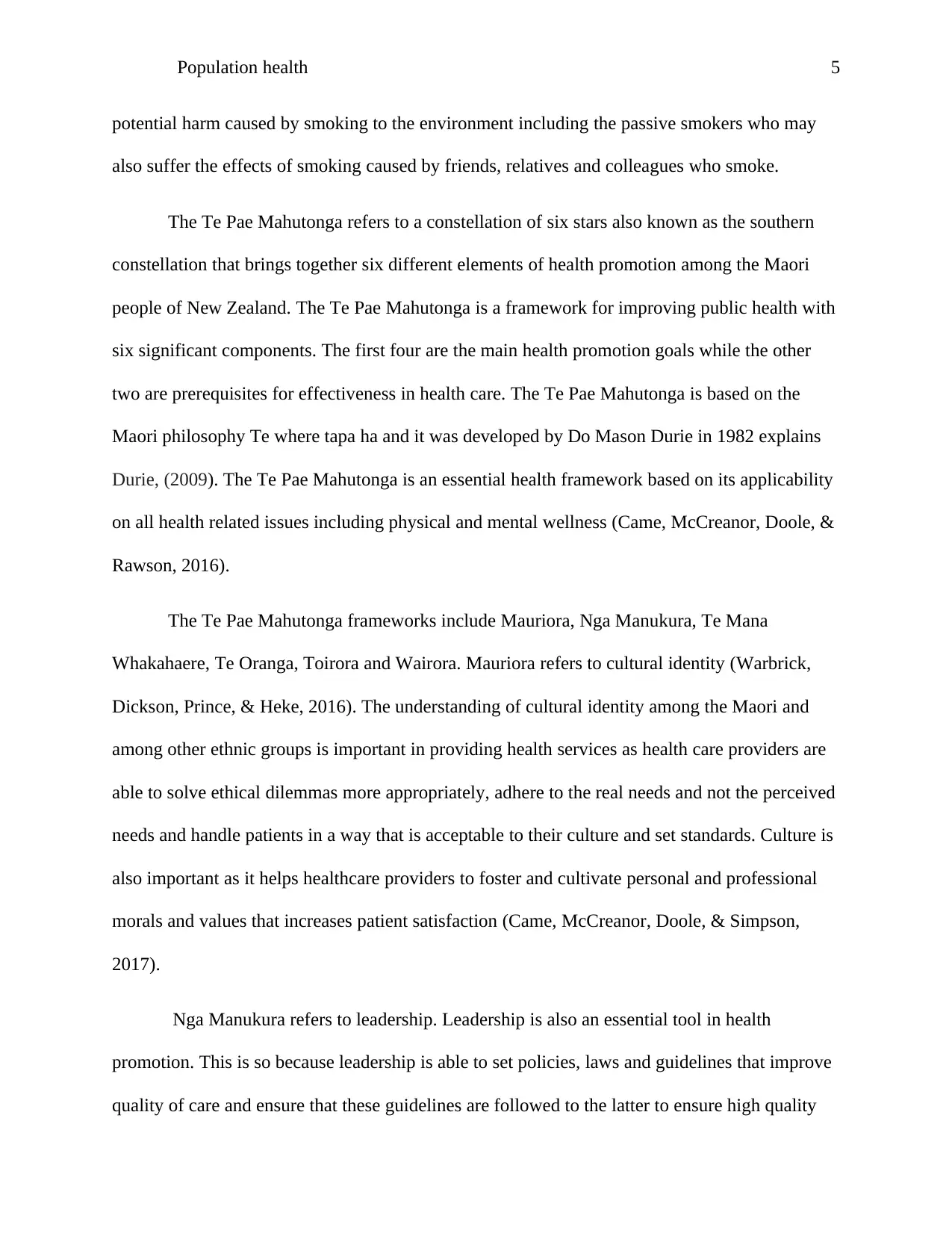
Population health 5
potential harm caused by smoking to the environment including the passive smokers who may
also suffer the effects of smoking caused by friends, relatives and colleagues who smoke.
The Te Pae Mahutonga refers to a constellation of six stars also known as the southern
constellation that brings together six different elements of health promotion among the Maori
people of New Zealand. The Te Pae Mahutonga is a framework for improving public health with
six significant components. The first four are the main health promotion goals while the other
two are prerequisites for effectiveness in health care. The Te Pae Mahutonga is based on the
Maori philosophy Te where tapa ha and it was developed by Do Mason Durie in 1982 explains
Durie, (2009). The Te Pae Mahutonga is an essential health framework based on its applicability
on all health related issues including physical and mental wellness (Came, McCreanor, Doole, &
Rawson, 2016).
The Te Pae Mahutonga frameworks include Mauriora, Nga Manukura, Te Mana
Whakahaere, Te Oranga, Toirora and Wairora. Mauriora refers to cultural identity (Warbrick,
Dickson, Prince, & Heke, 2016). The understanding of cultural identity among the Maori and
among other ethnic groups is important in providing health services as health care providers are
able to solve ethical dilemmas more appropriately, adhere to the real needs and not the perceived
needs and handle patients in a way that is acceptable to their culture and set standards. Culture is
also important as it helps healthcare providers to foster and cultivate personal and professional
morals and values that increases patient satisfaction (Came, McCreanor, Doole, & Simpson,
2017).
Nga Manukura refers to leadership. Leadership is also an essential tool in health
promotion. This is so because leadership is able to set policies, laws and guidelines that improve
quality of care and ensure that these guidelines are followed to the latter to ensure high quality
potential harm caused by smoking to the environment including the passive smokers who may
also suffer the effects of smoking caused by friends, relatives and colleagues who smoke.
The Te Pae Mahutonga refers to a constellation of six stars also known as the southern
constellation that brings together six different elements of health promotion among the Maori
people of New Zealand. The Te Pae Mahutonga is a framework for improving public health with
six significant components. The first four are the main health promotion goals while the other
two are prerequisites for effectiveness in health care. The Te Pae Mahutonga is based on the
Maori philosophy Te where tapa ha and it was developed by Do Mason Durie in 1982 explains
Durie, (2009). The Te Pae Mahutonga is an essential health framework based on its applicability
on all health related issues including physical and mental wellness (Came, McCreanor, Doole, &
Rawson, 2016).
The Te Pae Mahutonga frameworks include Mauriora, Nga Manukura, Te Mana
Whakahaere, Te Oranga, Toirora and Wairora. Mauriora refers to cultural identity (Warbrick,
Dickson, Prince, & Heke, 2016). The understanding of cultural identity among the Maori and
among other ethnic groups is important in providing health services as health care providers are
able to solve ethical dilemmas more appropriately, adhere to the real needs and not the perceived
needs and handle patients in a way that is acceptable to their culture and set standards. Culture is
also important as it helps healthcare providers to foster and cultivate personal and professional
morals and values that increases patient satisfaction (Came, McCreanor, Doole, & Simpson,
2017).
Nga Manukura refers to leadership. Leadership is also an essential tool in health
promotion. This is so because leadership is able to set policies, laws and guidelines that improve
quality of care and ensure that these guidelines are followed to the latter to ensure high quality
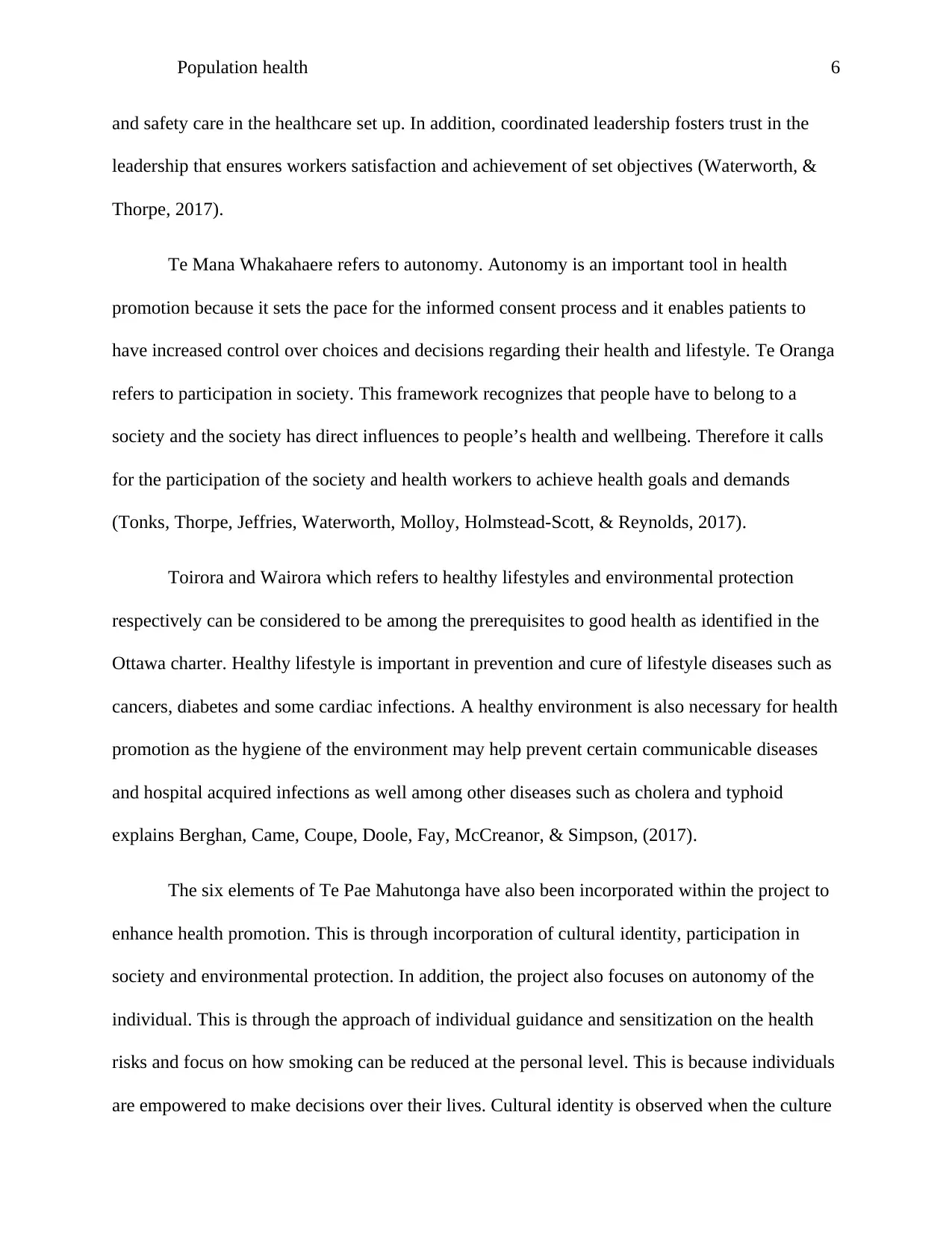
Population health 6
and safety care in the healthcare set up. In addition, coordinated leadership fosters trust in the
leadership that ensures workers satisfaction and achievement of set objectives (Waterworth, &
Thorpe, 2017).
Te Mana Whakahaere refers to autonomy. Autonomy is an important tool in health
promotion because it sets the pace for the informed consent process and it enables patients to
have increased control over choices and decisions regarding their health and lifestyle. Te Oranga
refers to participation in society. This framework recognizes that people have to belong to a
society and the society has direct influences to people’s health and wellbeing. Therefore it calls
for the participation of the society and health workers to achieve health goals and demands
(Tonks, Thorpe, Jeffries, Waterworth, Molloy, Holmstead-Scott, & Reynolds, 2017).
Toirora and Wairora which refers to healthy lifestyles and environmental protection
respectively can be considered to be among the prerequisites to good health as identified in the
Ottawa charter. Healthy lifestyle is important in prevention and cure of lifestyle diseases such as
cancers, diabetes and some cardiac infections. A healthy environment is also necessary for health
promotion as the hygiene of the environment may help prevent certain communicable diseases
and hospital acquired infections as well among other diseases such as cholera and typhoid
explains Berghan, Came, Coupe, Doole, Fay, McCreanor, & Simpson, (2017).
The six elements of Te Pae Mahutonga have also been incorporated within the project to
enhance health promotion. This is through incorporation of cultural identity, participation in
society and environmental protection. In addition, the project also focuses on autonomy of the
individual. This is through the approach of individual guidance and sensitization on the health
risks and focus on how smoking can be reduced at the personal level. This is because individuals
are empowered to make decisions over their lives. Cultural identity is observed when the culture
and safety care in the healthcare set up. In addition, coordinated leadership fosters trust in the
leadership that ensures workers satisfaction and achievement of set objectives (Waterworth, &
Thorpe, 2017).
Te Mana Whakahaere refers to autonomy. Autonomy is an important tool in health
promotion because it sets the pace for the informed consent process and it enables patients to
have increased control over choices and decisions regarding their health and lifestyle. Te Oranga
refers to participation in society. This framework recognizes that people have to belong to a
society and the society has direct influences to people’s health and wellbeing. Therefore it calls
for the participation of the society and health workers to achieve health goals and demands
(Tonks, Thorpe, Jeffries, Waterworth, Molloy, Holmstead-Scott, & Reynolds, 2017).
Toirora and Wairora which refers to healthy lifestyles and environmental protection
respectively can be considered to be among the prerequisites to good health as identified in the
Ottawa charter. Healthy lifestyle is important in prevention and cure of lifestyle diseases such as
cancers, diabetes and some cardiac infections. A healthy environment is also necessary for health
promotion as the hygiene of the environment may help prevent certain communicable diseases
and hospital acquired infections as well among other diseases such as cholera and typhoid
explains Berghan, Came, Coupe, Doole, Fay, McCreanor, & Simpson, (2017).
The six elements of Te Pae Mahutonga have also been incorporated within the project to
enhance health promotion. This is through incorporation of cultural identity, participation in
society and environmental protection. In addition, the project also focuses on autonomy of the
individual. This is through the approach of individual guidance and sensitization on the health
risks and focus on how smoking can be reduced at the personal level. This is because individuals
are empowered to make decisions over their lives. Cultural identity is observed when the culture
⊘ This is a preview!⊘
Do you want full access?
Subscribe today to unlock all pages.

Trusted by 1+ million students worldwide
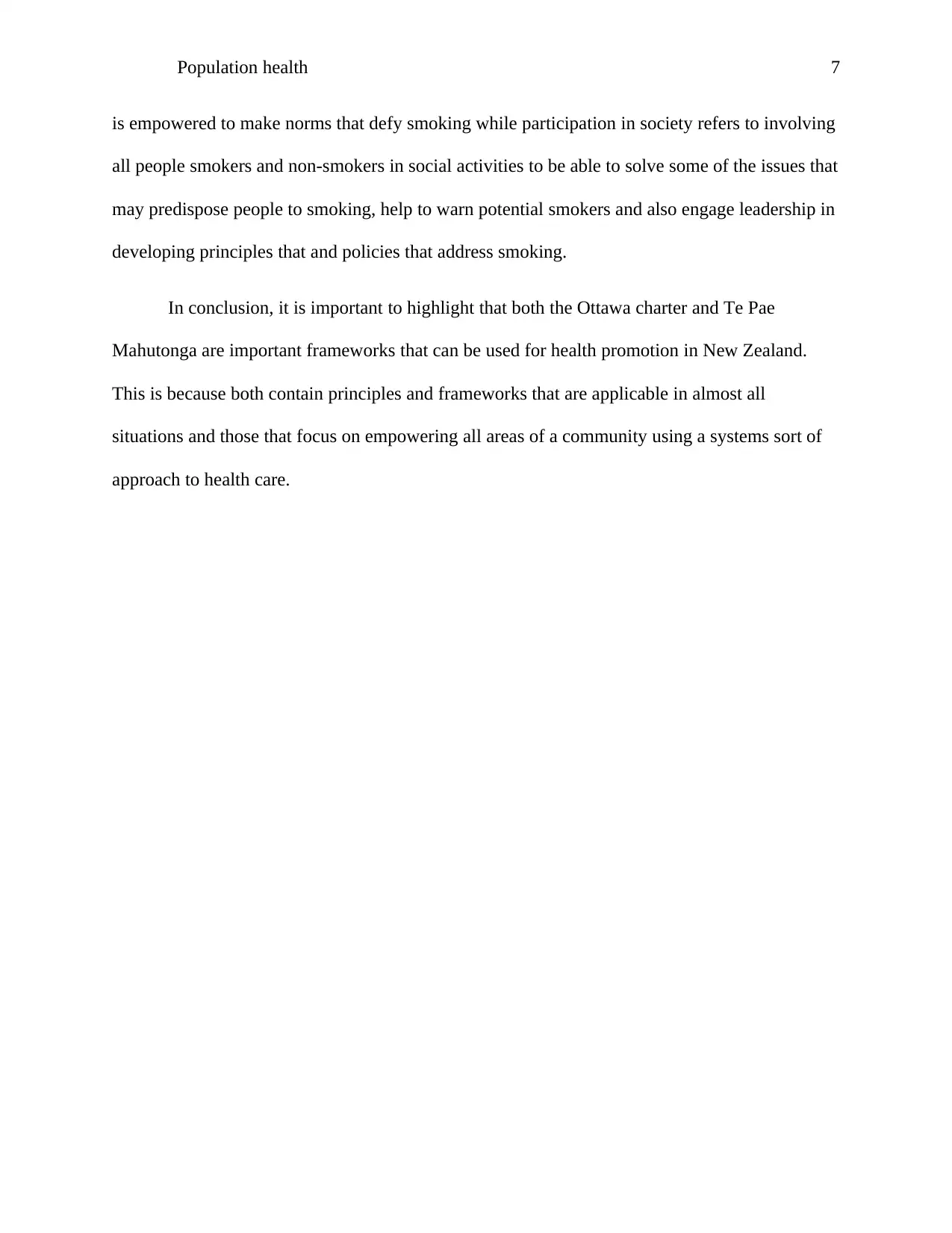
Population health 7
is empowered to make norms that defy smoking while participation in society refers to involving
all people smokers and non-smokers in social activities to be able to solve some of the issues that
may predispose people to smoking, help to warn potential smokers and also engage leadership in
developing principles that and policies that address smoking.
In conclusion, it is important to highlight that both the Ottawa charter and Te Pae
Mahutonga are important frameworks that can be used for health promotion in New Zealand.
This is because both contain principles and frameworks that are applicable in almost all
situations and those that focus on empowering all areas of a community using a systems sort of
approach to health care.
is empowered to make norms that defy smoking while participation in society refers to involving
all people smokers and non-smokers in social activities to be able to solve some of the issues that
may predispose people to smoking, help to warn potential smokers and also engage leadership in
developing principles that and policies that address smoking.
In conclusion, it is important to highlight that both the Ottawa charter and Te Pae
Mahutonga are important frameworks that can be used for health promotion in New Zealand.
This is because both contain principles and frameworks that are applicable in almost all
situations and those that focus on empowering all areas of a community using a systems sort of
approach to health care.
Paraphrase This Document
Need a fresh take? Get an instant paraphrase of this document with our AI Paraphraser
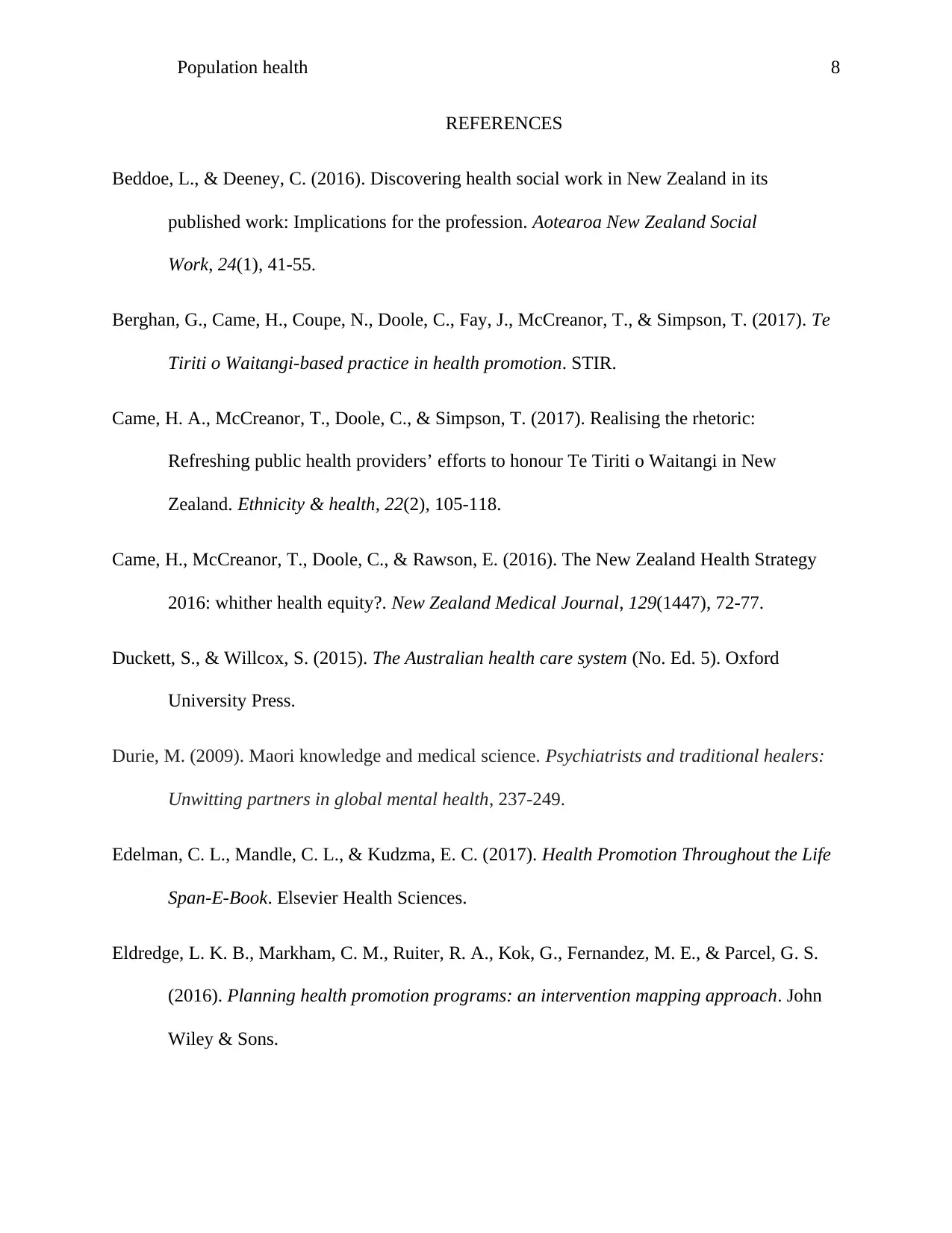
Population health 8
REFERENCES
Beddoe, L., & Deeney, C. (2016). Discovering health social work in New Zealand in its
published work: Implications for the profession. Aotearoa New Zealand Social
Work, 24(1), 41-55.
Berghan, G., Came, H., Coupe, N., Doole, C., Fay, J., McCreanor, T., & Simpson, T. (2017). Te
Tiriti o Waitangi-based practice in health promotion. STIR.
Came, H. A., McCreanor, T., Doole, C., & Simpson, T. (2017). Realising the rhetoric:
Refreshing public health providers’ efforts to honour Te Tiriti o Waitangi in New
Zealand. Ethnicity & health, 22(2), 105-118.
Came, H., McCreanor, T., Doole, C., & Rawson, E. (2016). The New Zealand Health Strategy
2016: whither health equity?. New Zealand Medical Journal, 129(1447), 72-77.
Duckett, S., & Willcox, S. (2015). The Australian health care system (No. Ed. 5). Oxford
University Press.
Durie, M. (2009). Maori knowledge and medical science. Psychiatrists and traditional healers:
Unwitting partners in global mental health, 237-249.
Edelman, C. L., Mandle, C. L., & Kudzma, E. C. (2017). Health Promotion Throughout the Life
Span-E-Book. Elsevier Health Sciences.
Eldredge, L. K. B., Markham, C. M., Ruiter, R. A., Kok, G., Fernandez, M. E., & Parcel, G. S.
(2016). Planning health promotion programs: an intervention mapping approach. John
Wiley & Sons.
REFERENCES
Beddoe, L., & Deeney, C. (2016). Discovering health social work in New Zealand in its
published work: Implications for the profession. Aotearoa New Zealand Social
Work, 24(1), 41-55.
Berghan, G., Came, H., Coupe, N., Doole, C., Fay, J., McCreanor, T., & Simpson, T. (2017). Te
Tiriti o Waitangi-based practice in health promotion. STIR.
Came, H. A., McCreanor, T., Doole, C., & Simpson, T. (2017). Realising the rhetoric:
Refreshing public health providers’ efforts to honour Te Tiriti o Waitangi in New
Zealand. Ethnicity & health, 22(2), 105-118.
Came, H., McCreanor, T., Doole, C., & Rawson, E. (2016). The New Zealand Health Strategy
2016: whither health equity?. New Zealand Medical Journal, 129(1447), 72-77.
Duckett, S., & Willcox, S. (2015). The Australian health care system (No. Ed. 5). Oxford
University Press.
Durie, M. (2009). Maori knowledge and medical science. Psychiatrists and traditional healers:
Unwitting partners in global mental health, 237-249.
Edelman, C. L., Mandle, C. L., & Kudzma, E. C. (2017). Health Promotion Throughout the Life
Span-E-Book. Elsevier Health Sciences.
Eldredge, L. K. B., Markham, C. M., Ruiter, R. A., Kok, G., Fernandez, M. E., & Parcel, G. S.
(2016). Planning health promotion programs: an intervention mapping approach. John
Wiley & Sons.
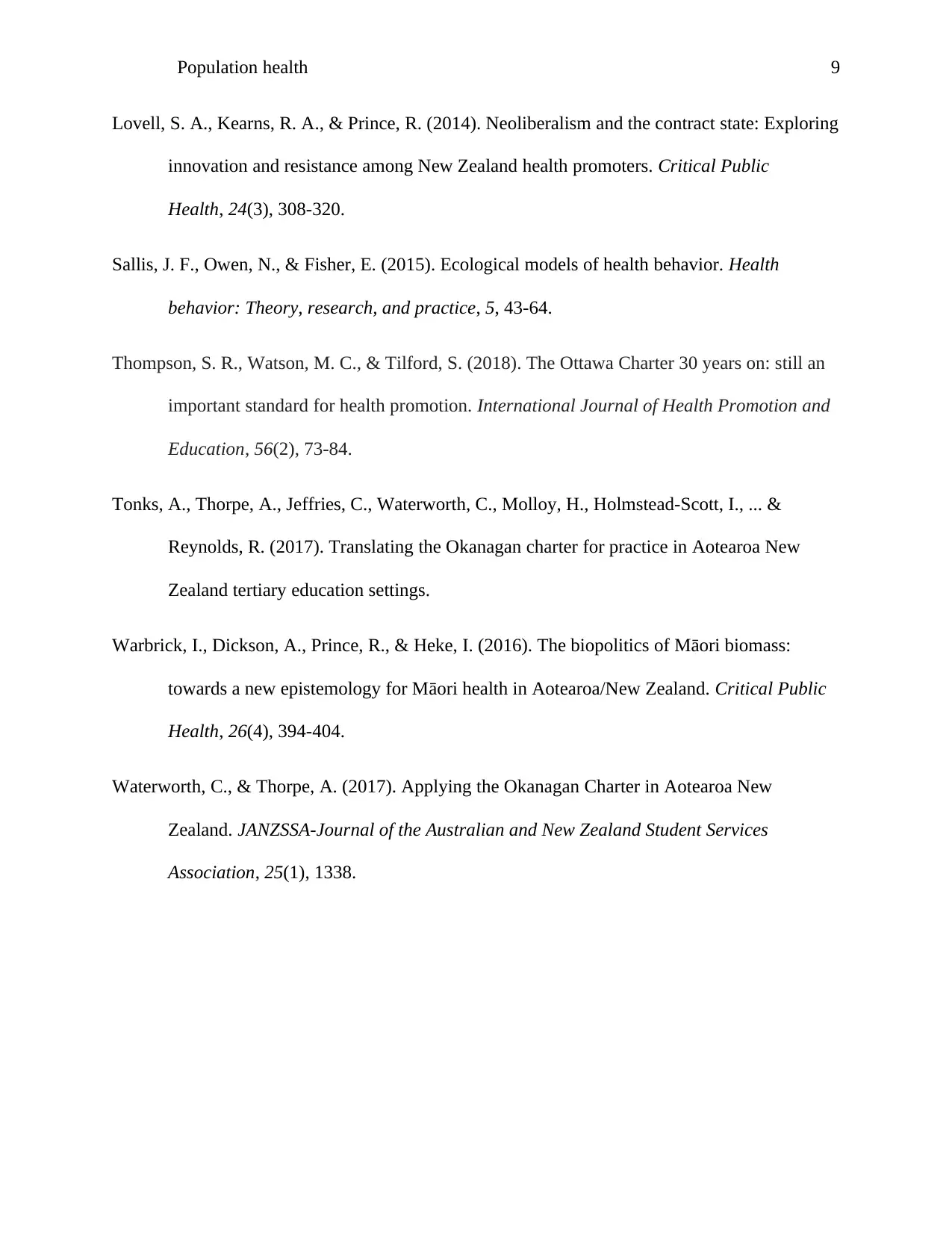
Population health 9
Lovell, S. A., Kearns, R. A., & Prince, R. (2014). Neoliberalism and the contract state: Exploring
innovation and resistance among New Zealand health promoters. Critical Public
Health, 24(3), 308-320.
Sallis, J. F., Owen, N., & Fisher, E. (2015). Ecological models of health behavior. Health
behavior: Theory, research, and practice, 5, 43-64.
Thompson, S. R., Watson, M. C., & Tilford, S. (2018). The Ottawa Charter 30 years on: still an
important standard for health promotion. International Journal of Health Promotion and
Education, 56(2), 73-84.
Tonks, A., Thorpe, A., Jeffries, C., Waterworth, C., Molloy, H., Holmstead-Scott, I., ... &
Reynolds, R. (2017). Translating the Okanagan charter for practice in Aotearoa New
Zealand tertiary education settings.
Warbrick, I., Dickson, A., Prince, R., & Heke, I. (2016). The biopolitics of Māori biomass:
towards a new epistemology for Māori health in Aotearoa/New Zealand. Critical Public
Health, 26(4), 394-404.
Waterworth, C., & Thorpe, A. (2017). Applying the Okanagan Charter in Aotearoa New
Zealand. JANZSSA-Journal of the Australian and New Zealand Student Services
Association, 25(1), 1338.
Lovell, S. A., Kearns, R. A., & Prince, R. (2014). Neoliberalism and the contract state: Exploring
innovation and resistance among New Zealand health promoters. Critical Public
Health, 24(3), 308-320.
Sallis, J. F., Owen, N., & Fisher, E. (2015). Ecological models of health behavior. Health
behavior: Theory, research, and practice, 5, 43-64.
Thompson, S. R., Watson, M. C., & Tilford, S. (2018). The Ottawa Charter 30 years on: still an
important standard for health promotion. International Journal of Health Promotion and
Education, 56(2), 73-84.
Tonks, A., Thorpe, A., Jeffries, C., Waterworth, C., Molloy, H., Holmstead-Scott, I., ... &
Reynolds, R. (2017). Translating the Okanagan charter for practice in Aotearoa New
Zealand tertiary education settings.
Warbrick, I., Dickson, A., Prince, R., & Heke, I. (2016). The biopolitics of Māori biomass:
towards a new epistemology for Māori health in Aotearoa/New Zealand. Critical Public
Health, 26(4), 394-404.
Waterworth, C., & Thorpe, A. (2017). Applying the Okanagan Charter in Aotearoa New
Zealand. JANZSSA-Journal of the Australian and New Zealand Student Services
Association, 25(1), 1338.
⊘ This is a preview!⊘
Do you want full access?
Subscribe today to unlock all pages.

Trusted by 1+ million students worldwide
1 out of 9
Related Documents
Your All-in-One AI-Powered Toolkit for Academic Success.
+13062052269
info@desklib.com
Available 24*7 on WhatsApp / Email
![[object Object]](/_next/static/media/star-bottom.7253800d.svg)
Unlock your academic potential
Copyright © 2020–2025 A2Z Services. All Rights Reserved. Developed and managed by ZUCOL.





